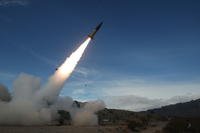
Army aviation officials, including several from the special operations side of the house, last week revealed that the special operations community will have a say in the design of the next generation of Army choppers.
When asked last week during an army aviation conference sponsored by the Association of the U.S. Army last week if the Army's 160th Special Operations Aviation Regiment will get its own tricked out version of the service's new armed aerial scout (AAS) chopper, Col. Vincent Reap, deputy commander of the 160th said no, but:
Attributes of being faster are certainly better, a lesser signature is better whether that signature be acoustic, visual or other [think radar and infrared evading stealth tech].
Whether or not SOF [special operations forces] would see that as a requirement peculiar from what the Army is looking at for its AAS, I don't think that is necessarily true. Even were it true, certainly we believe that SOF wouldn't be able to afford it. SOCOM and its resourcing authority does not stand to be able to build an aircraft that would be unique and sort of disparate from what the Army would do.
In short, no, but the more detailed answer would be a discussion and sharing of the particular requirements that SOF would see for rotary wing fire support platforms tied very closely with the Army as it needs to do and perhaps modify as necessary.
While the 160th -- and from what Reap said, big Army aviation -- are hoping to get a faster, stealthier scout chopper, it will be interesting to see how that requirement plays out against the services planned demo of existing choppers that could be pressed into service as the next gen scout. All of the birds slated to fly in that effort are existing airframes that don't offer a huge leap ahead in speed and stealth. Then again, they could be modified for the 160th like the stealth Black Hawks that were used for the raid on Osama bin Laden's compound last year.
Enter special ops contributions to the Joint Multirole Rotorcraft (JMR) effort:
As soon as Reap was done speaking, his fellow aviator, Col. Charles Yomant -- who has the vague title of Director, Army Compartmented Element, United States Army Special Operations Command -- said that the Army's SOF community is making sure spec ops capabilities are included in the service's effort to develop a next-generation family of helos under the Joint Multirole Rotorcraft project.
"We're working very closely with [Maj. Gen. Anthony Crutchfield's] team on inserting our requirements into the future vertical lift, JMR, program so that they're built into the platform up front.
Crutchfield himself then chimed in, saying that a SOF aviator is working with his team at Fort Rucker, Ala., to make sure that JMR is developed with special operations missions in mind.
What we need to do is do what we're saying right now; make sure as we're laying out requirements for the future vertical lift that it includes what SOF aviation needs. Even in the end state, there will be special packages on that same airframe, every aircraft will not be outfitted as a special operations aircraft. But, if we don't share requirements, we don't share ideas now, I think it will be too late in the end when we get to 2030.Again, we are including the requirements of special operations aviation [in the JMR effort] which I'm not sure we've done a good job of in the past.
This last sentence is very interesting since JMR, or potentially AAS, would mark the first time a brand new Army helo is designed from the ground up to accomodate SOF missions. Think about it, the entire Army spec ops aviation fleet is made up of modified designs -- MH-60s, MH-6s and MH-47s -- that predate the 160th SOAR.
(The image above are Army concepts of what JMR might look like)








